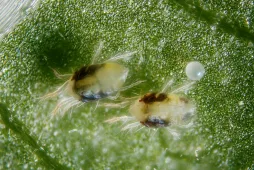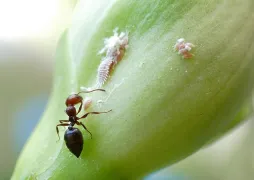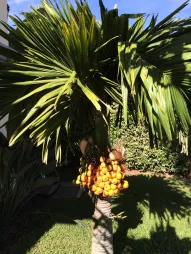The Areca palm, bringing sunshine into your home
The Areca palm, Dypsis lutescens by its scientific name, belongs to the Arecaceae family, the same as the Areca catechu. It comes to us from the rainforests of Madagascar. But you don't have to live on a paradise island to enjoy it. In our latitudes, it's grown indoors, giving our living rooms a jungle or eternal-summer feel.
How to recognize the Areca palm, Dypsis lutescens?
The Areca palm, Dypsis lutescens, reaches heights of nine to twelve meters in its natural habitat. In pots and indoors, it grows to no more than three meters. Whatever the growing conditions, its habit remains upright and bushy.
The Areca palm has no trunk or stem, but a stipe. It measures seven to eight centimetres in diameter. Green and smooth, it is covered with yellow leaf bases. Dypsis lutescens produces suckers. These grow alongside the mother plant. Over the years, the shrub develops into a dense, decorative grove with multiple stipes. This is why it is sometimes called a multiplying palm.
Its evergreen foliage consists of a crown of green, yellowish palms. The oldest ones are even gold in color, hence the nickname "golden palm". Each palm has around fifty pairs of lanceolate leaflets.
In the wild, Dypsis lutescens blooms in summer. Three-petaled yellow flowers bloom in clusters beneath the crown.
When fertilized, they develop into fruits measuring no more than two centimetres. Elongated and asymmetrical, they are born yellow and turn brown or mauve when ripe.
The Areca Palm, like saw Palmetto, is not toxic to humans or animals. You can adopt it even if you live with a cat, dog or children. However, its palms can be sharp.
Our maintenance tips
Areca Palms are easy to grow. To avoid killing them, you need to remember two things:
1. Palms need light. Be careful, however, not to expose it to full southern exposure: too much sun will burn its foliage.
2. Indoor palms like humidity, but hate excess water. Over-watering can rot the roots.
Watering
Areca Palms appreciate constant but moderate humidity. Before watering your plant, make sure it needs it by touching the surface of the potting soil. If two or three centimetres of the surface is dry, you can water.
If you can, use non-calcareous water such as rainwater or filtered water.
Make sure the water doesn't stagnate in the saucer or planter.
If you can, use non-calcareous water such as rainwater or filtered water.
Make sure the water doesn't stagnate in the saucer or planter.
Spray
In addition to regular watering, misting prevents the plant from drying out due to heat in summer and heating in winter.
Areca Palms do not like hard water. Preferrainwater or filtered water.
Repotting
In spring, transfer your Dypsis lutescens to a larger pot, so that it can continue to grow.
Areca Palmlike all palms, likes to be cramped. Re-pot only if the roots protrude from the drain hole, if they grow on the surface or if the root system rotates in the pot.
The day before repotting, water the root ball and soak the clay pot. This way, it won't absorb all the water during the first watering.
In a pierced terracotta or clay pot, pour a drainage layer (gravel, clay balls) followed by the substrate. You can choose a potting soil for green plants or for citrus and Mediterranean plants.
Fertilization
You can stimulate the development of your plant during its growth phase, in spring and summer, with fertilizer.
To promote the growth of your Dypsis lutescens, feed the plant with a liquid green plant fertilizer diluted in the water.
Cleaning
The dust that accumulates on the leaves interferes with photosynthesis and slows down your plant's development. To allow it to take advantage of the light, clean the top and bottom of the foliage with a clean, damp cloth.
Don't use any polish, as it will damage the limbs.
Prune
Remove dry palms by cutting them off at the base. Use clean pruning shears to prevent the spread of disease.
Plantation
Once the last spring frosts have passed, you can plant.
Soak the root ball of your palm tree to rehydrate it.
Select a bright location, but away from direct sunlight. Dig a hole 80 centimetres deep and three times as wide as the root ball. Place clay balls or other material at the bottom to promote drainage. Add a mixture of garden soil, potting soil and sand.
Plant your specimen in the center. Fill in with your substrate until the collar is buried. Water for the first time after planting.
Seedling
Soak seeds in hot water for 48 to 72 hours. Don't hesitate to change the water if it becomes cloudy.
Prepare a one-liter pot for each seed, filled with special potting soil and perlite. Plant the seed two centimetres deep, without burying it completely. Cover and place the pots in a room with a temperature above 20 degrees.
Keep the substrate moist until the seeds begin to germinate.
Diseases / Threats
Information
| Family | Arecaceae - Arecaceae |
| Type | Dypsis - Dypsis |
| Species | Dypsis lutescens - Dypsis lutescens |
| Lifecycle | Perennial |
| Foliage | Evergreen |
| Exposures | |
| Substrats | |
| Planting methods |
Open ground In pots In tubs |
| Categories | |
| Tags |
Beginner Increvable |
| Origin |
East Africa |
| Hardiness (USDA) | 10a |
| Leaf color |
|
| Flower color |
|
| Fruit color |
|
Discover plants from the same family


























